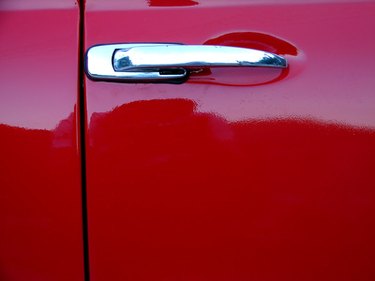Things You'll Need
Siphon spray gun
Air compressor
Respirator
Scrap wood or metal
1 gallon acrylic enamel reducer
Fine-grit sandpaper, 220-grit or 400-grit
Clean cloth
Polishing compound or wax
Lambswool polishing cloth

Automotive acrylic enamel is not just for automobiles. It is a durable finish that can be used on any metal, plastic or wooden surface. Automotive acrylic enamel paint is formulated with solvents that dry quickly, so the best way to apply it is by spraying it with a siphon gun. Rolling or brushing it on won't properly level out the enamel, and an airless sprayer pumps out too much material for a fine finish. It's not challenging to spray with a siphon gun. Spray outside, if you wish, but choose a cloudy day that is dry and not too hot.
Step 1
Fill the cup of a siphon gun about 3/4 full of acrylic enamel and screw the cup onto the gun. Put on a respirator and then turn on the compressor. Test the spray pattern on a scrap piece of wood or metal.
Video of the Day
Step 2
Adjust the air pressure and the nozzle of the gun until you get a spray pattern that is about 6 inches wide from a distance of 6 inches. Loosen spray that is too thin by adjusting the nozzle or add reducer to the paint. Add reducer if the spray is chunky or uneven.
Step 3
Hold the gun about 6 inches from the surface to be sprayed and pull the trigger. Keep the trigger depressed while you move the gun in a steady up-down or back-and-forth motion, overlapping about half of the spray pattern on each pass. Maintain the same distance from the surface as you move the gun; don't let it arc away from the surface as you approach the ends.
Step 4
When you have finished spraying the surface in one direction, immediately spray it again in the perpendicular direction to form a cross-hatch pattern. Correct drips after the paint dries.
Step 5
Let the enamel dry for at least two hours, and then sand it with fine sandpaper. Sand any drips until they are flat with the surface. Clean off the sanding dust with a clean cloth and spray the surface again in a cross-hatch pattern. When the paint dries, sand and spray a third coat if necessary. Do not sand the final coat.
Step 6
Polish the final coat with polishing compound or wax and a lambswool polishing cloth, if desired.
Tip
Hold the gun a little farther away from the spray surface to avoid drips.
Do not spray a surface that has wax or silicone on it. The paint won't adhere and may separate, creating a messy cleanup for you.
Clean the gun between uses by washing out the cup with reducer, immersing the tip in reducer and then wiping it with a clean cloth. Then spray a little thinner through the gun.
Warning
The fumes from acrylic enamel are harmful to lungs and the central nervous system. Wear a respirator and spray in a well-ventilated location.
Video of the Day